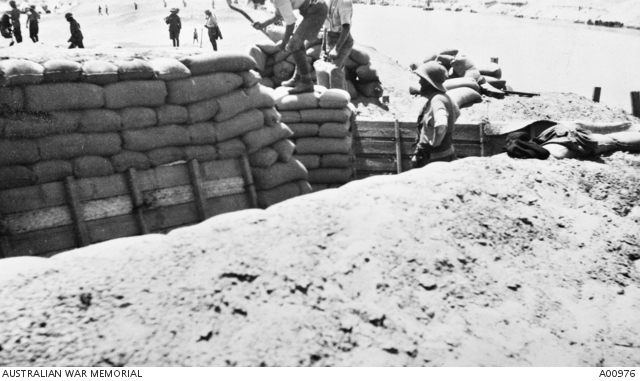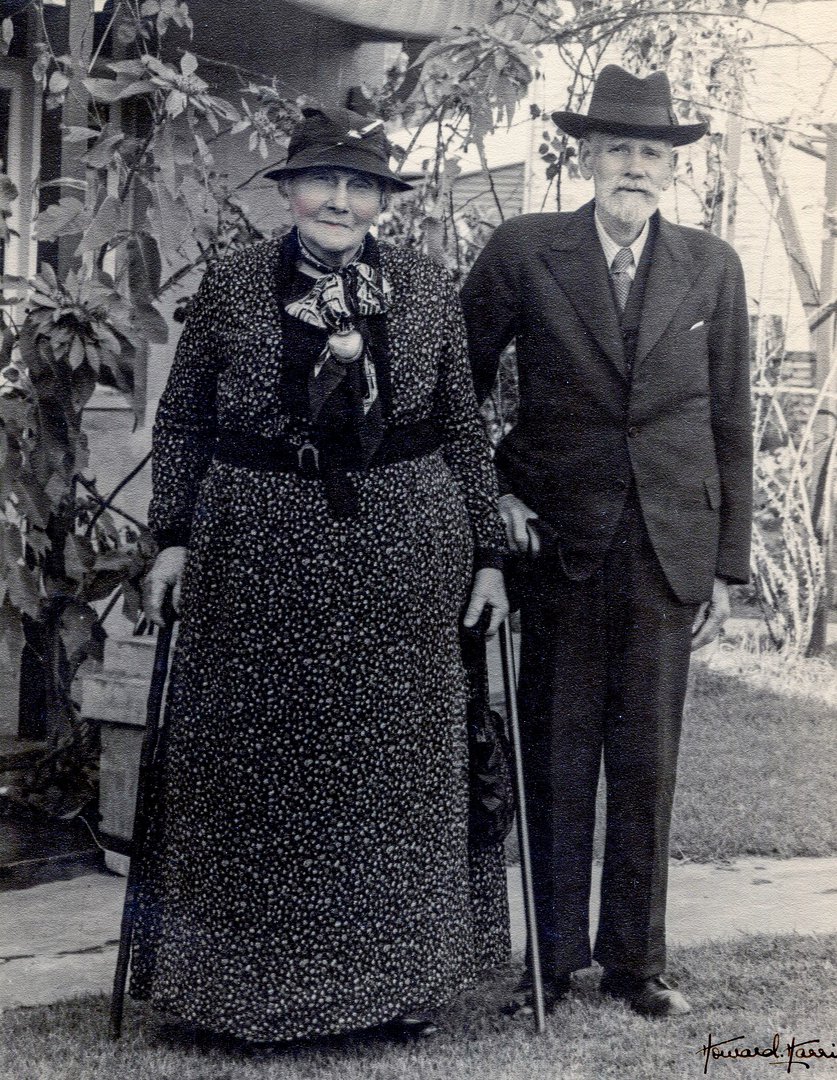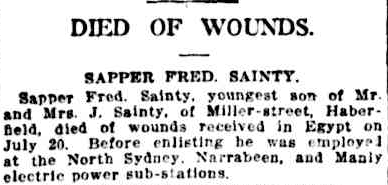
Frederick Leslie SAINTY
Eyes blue, Hair brown, Complexion fresh
A mother’s testament to her son killed at Fromelles
We are grateful to Graeme Hosken, Trevor Edwards and FFAIF for approving our use of their article on Frederick Sainty in the DIGGER journal 78 (March 2022) as the basis for this story.
The following was written by Sapper Frederick L. Sainty’s mother, Louisa, in the early 1920s:
“He was the youngest of a family of 12. A good pianist & very popular. Was a great reader, particularly of historical works. From his childhood he was fearless & on one occasion when only a boy was the means of saving a little boy’s life. In France he acted as a despatch rider. [He] requested the position of Engineers Storeman in order to take part in battle in which he was killed.”

Frederick was remembered with fondness and respect throughout ensuing generations. His great-nephew, Trevor Edwards, recalls his father (Douglas John Edwards) speaking about his uncle Fred. Douglas was himself a 2nd AIF veteran and he showed great interest in the Fromelles dig, even agreeing to give DNA samples in the hope that they may one day assist in identifying his uncle – a hope that remains unfulfilled.
The Sainty family
Frederick’s parents were Louisa (nee Gregory) and James Sier Sainty, living initially in Lane Cove but later in Newtown and Haberfield, Sydney. Their five sons and seven daughters were born over a period of twenty-one years, with Frederick the youngest born in 1897. James, senior, was employed variously as a lamplighter, labourer and builder and the family moved to a house name Nami-ko in Miller Street, Haberfield.
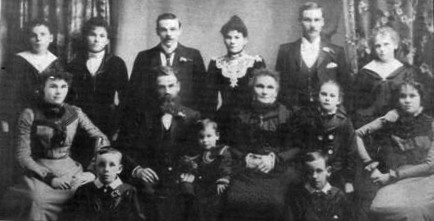
Back Row: Bertha Allen 1887-1965, Elizabeth Wells 1880-1949, James Sainty jr 1876-1928, Eadie Griffin 1881-1954, Alfred Sainty 1878-1955, Sadie Williams 1888-1979
Middle Row: Lavinia Gunter 1883-1938, James Sainty sr 1852-1937, Frederick Sainty 1897-1916, Louisa Sainty 1852-1942, Thelma Edwards 1894-1970, Violet Burling 1885-1975
Front Row: Ernest Sainty 1892-1941, Hezekiah Sainty 1890-1975
Born in Newtown on 7 December 1897, Fred was educated at the Fort Street Public School and the Sydney Technical High School. He was subsequently employed as a junior electrical engineer with the power sub-stations at North Sydney, Narrabeen and Manly.
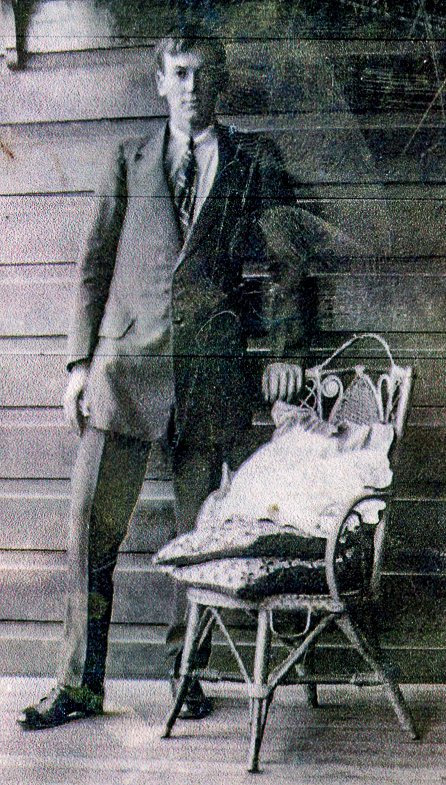
Enlistment
Keen to enlist, Fred signed up a few months shy of his eighteenth birthday but lied on his paperwork claiming to be 18 years and three months old. His medical examination record dated August 1915 show him as standing 5 feet 9 inches tall and weighing 136 pounds with a 33-35½ inch chest - so it would not have been hard to convince the doctor that he was over 18. He had a fresh complexion, blue eyes and brown hair and he listed his religious denomination as Church of England.
With his engineering background, he was assigned to the Engineer Depot at Moore Park for initial training. On 20 November 1915, Fred was then allocated to the 12th Reinforcements of the 1st Field Company Engineers (1st Brigade/1st Division) as a sapper (equivalent to a private).
The 12th reinforcements consisted mainly of men from the (now) inner-western suburbs of Sydney and the North Shore. They embarked from Sydney on board HMAT RMS Mooltan on 11 December 1915 (four days after Fred’s 18th birthday) under the command of 2nd Lieutenant John Stephen Ferguson, a 25-year-old architect from North Sydney who had also attended the Fort Street High School. Ferguson would die of wounds on 27 July 1916 and is buried in London (Kensal Green (St Mary’s) Roman Catholic Cemetery, Hammersmith, Row C, Grave 2459). His wounds were received eight days earlier at Fromelles on 19 July.
Egypt and France
After disembarking in Egypt, Fred marched into the Australian base at Tel-el-Kebir. On 18 March 1916, he was transferred to the 14th Field Company Engineers (14th FCE), which would provide engineering services to the 14th Brigade (NSW). They moved to the Suez Canal Defence Zone, replacing the 1st Division which had sailed to France in March 1916.
Fred, apart from two short periods where he was admitted to hospital for illness, served a further three months in Egypt before embarking on 18 June 1916 with the 14th FCE on the Kingfauns Castle , bound for Marseilles. They disembarked on 29 June and the men entrained for the Armentieres sector in Northern France.
Despite being the last of the four AIF divisions to arrive in France from Egypt, the 5th Division was the first to launch a major attack on the German line. The role of the engineers in the Battle of Fromelles was outlined by Roger Lee as:
Parties of engineers, pioneers and other infantry would dig communication trenches and saps from the attackers’ front lines to provide a more protected means of moving to the captured trenches.
The Battle of Fromelles commenced around 6 pm on 19 July and was over by 9 am on 20 July, with the survivors back in the jumping-off line. The Division incurred 5,533 casualties, with 470 taken prisoner and 1,917 killed in action.
Many of the dead had to be left in the German lines and in No-man’s land. Over the next three nights, volunteers ventured into No-man’s land to search for the wounded and bring them back to the Australian line. Many had to be left behind.
Fred Sainty died during the Battle of Fromelles aged just 18 years and seven months.
News for the Sainty family
And so began a sad litany of communications between military authorities and Fred’s family. Page references below refer to Fred’s AIF Personnel file.
5 August 1916 - a cable was sent from AIF Headquarters in London to Base Records in Australia that Sapper F. L. Sainty had died from wounds received in action on 20 July 1916 (p37 refers). As next of kin, Fred’s father, James Sainty senior, would have been notified in the following days.
13 August 1916 - James Sainty wrote to Base Records asking for his son’s death certificate as the life assurance office required it. (p32)
18 August 1916 - letter was sent by mail from London AIF Headquarters confirming details in cable of 5 August 1916. (p37 refers)
23 August 1916 – Major Lean from Base Records wrote advising that official documentation of Fred’s death yet to be received but they would send it at the earliest possible date. (p33)
13 September 1916 – Field service report of death of soldier, Sapper 2426 F. L. Sainty, finalized in Rouen France – soldier killed in action 20 July 1916 in France. (p 36)
20 October 1916 – Fred’s mother, Louisa Sainty, wrote to Base Records asking if they would:
“kindly let me know if you have yet received the death certificate of my son…….. We received a note from his lieutenant to say he was killed on the 20th July 1916 in France.”
5 November 1916 - Base Records sent certificate of report of death to Louisa Sainty (p9, 37)
Early December 1916 – Lieutenant Leslie G. Merkel, officer commanding Fred’s section, wrote to James Sainty advising that he was forwarding the pocket wallet belonging to Fred. (p17 refers)
17 December 1916 – Louisa Sainty wrote to Base Records asking if they had received Fred’s pocket wallet or any other personal items, including a wristlet watch. (p27)
21 December 1916 – Formal acknowledgement of receipt of 17 December letter sent. (p27)
April 1917 – Fred’s personal effects arrived in Australia on ship Benalla
18 April 1917 – Fred’s personal effects mailed from Melbourne to his father in Haberfield. (p20)
23 April 1917 – James Sainty received the parcel containing his son’s personal effects - a safety razor, 14 coins, a comb, photos, wallet, cards and letters. (p22)
23 April 1917 - James Sainty wrote to Base Records asking if his son’s watch – a gift from his siblings – had been recovered and also asking about his son’s deferred pay. (p26)
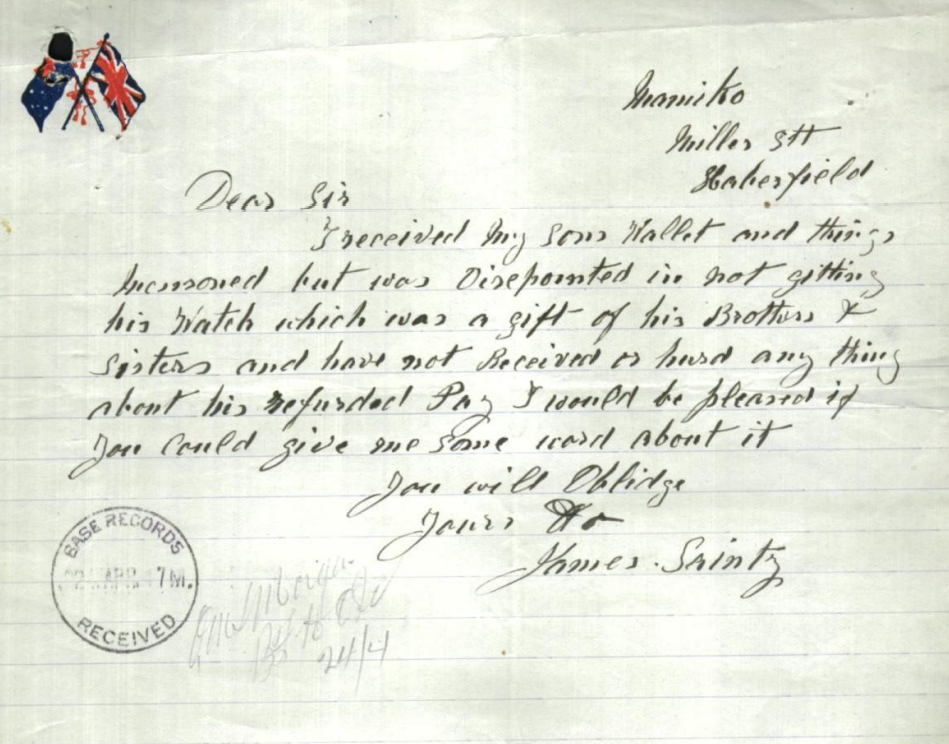
1 May 1917 – Base Records replied to James advising that his son’s deferred pay matters would be settled by the District Paymaster at Victoria Barracks as soon as possible and that the belongings forwarded constituted:
“the whole of the articles received from abroad to date. It is more than probable that his wounds were of such a nature as to preclude the recovery of the watch even if it was intact – needless to say, should it come to hand it will be promptly transmitted. “
In 1920, further communications began relating to Fred’s burial place.
28 August 1920 – Mr Robert Nesbitt wrote to Base Records on James Sainty’s behalf asking for the exact location of Fred’s grave as ‘many misgivings exist’ and he had been ‘led to believe that he was buried alongside V.C. Avenue, a trench leading to the front line on the Fromelles sector.’ (p28)
3 September 1920 – Base Records replied to James stating that no burial report had yet been received but that they were referring the matter to the Australian Graves Services (AGS) in London for further investigation. (p10)
18 November 1920 – AGS notified Base Records that no burial records were held and all efforts to trace Fred’s grave were unsuccessful adding
“.. that owing to the exceptional difficulties encountered in identification due to the entire of the engagement at Fromelles the percentage of identifications in that sector has been very low …”.
This last observation refers to the fact that between July 1916 and the end of the war, No-man’s land at Fromelles was never occupied by the Allies. Consequently, over 400 bodies were left on the battlefield to decompose and by 1919 the remains were unidentifiable.
4 January 1921 – Base Records wrote to James Sainty to pass on AGS’s advice that no burial information was held and explain the low identification rate in the Fromelles sector. (p18)
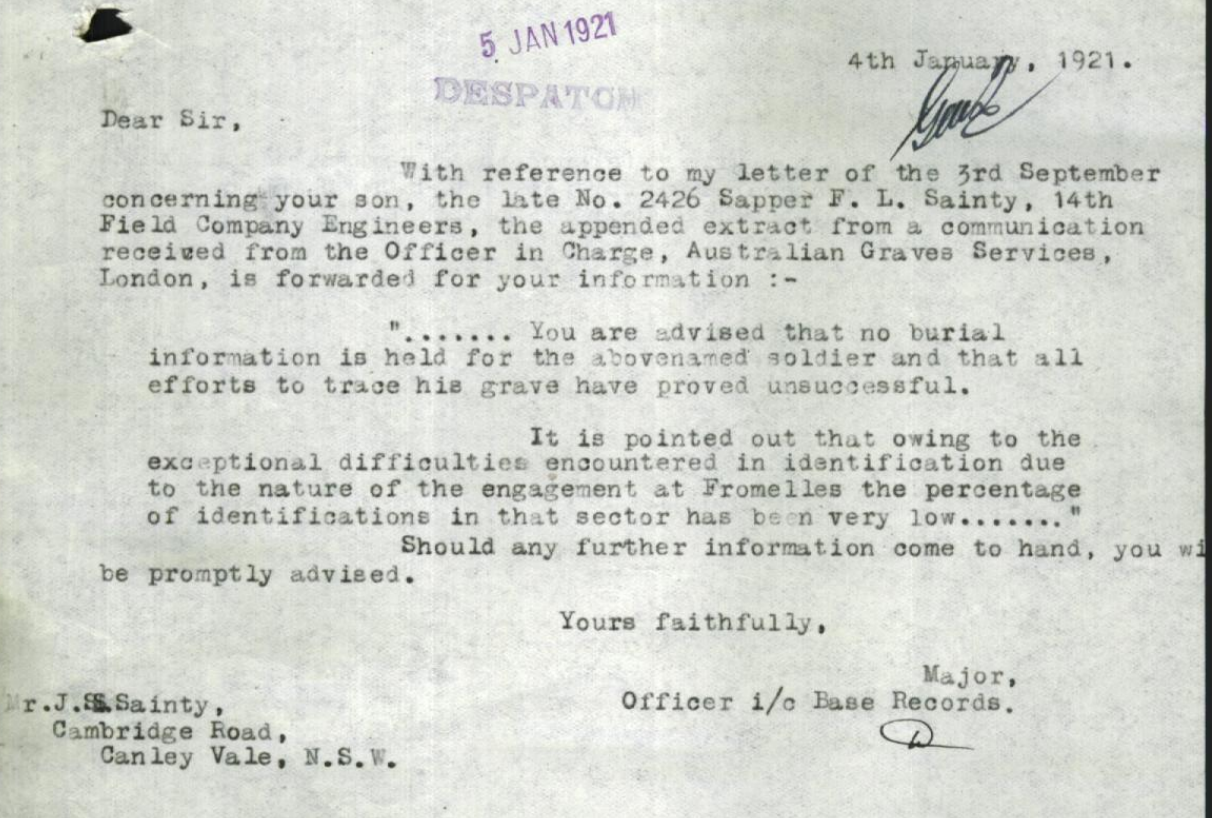
4 August 1922 – AGS provided final advice to Base Records that it had not been possible to locate Fred’s ‘probable original or present resting place’. (p14)
So, what happened to Fred?
Within Fred’s service records there are some inconsistencies. The date of his death is given as both 19 and 20 July 1916 and some records say he was ‘killed in action’ while others say he ‘died of wounds’. The Red Cross Inquiry Bureau in London obtained statements from 14th FCE survivors of the battle and recorded their sometimes conflicting evidence as to Fred’s fate.
Sapper 5022 Alfred SARFATY (33-year-old electrician from Five Dock) said:
“I was in the same section with him, No. 1. He came over with the 12th Reinforcements and joined the 14th Field Co. at Tel-el-Kebir. We were in action on the Fromelles front on the night of 19th July. We went over with the third wave. Sainty was killed by a shell in the support line before we went over. I believe his body was buried either at Fleurbaix or Bac St Maur but cannot be certain.”
L/Cpl 3747 George Owen BYWATER (30-year-old engineer from Randwick) gave a lengthy statement:
“Personally, I knew Sainty fairly well, as for time previous to July 19th he had been coming to me for treatment, as he had hurt one of his feet. As regards his personal appearance, I remember him as a young man, about 19 or 20, tall and slimly built, rather a white face, thin lips, black or dark-brown hair, eyes a light grey. Sapper Sainty was very popular with the company.
Some time previous to the 19th July he had been entrusted with the important duty of despatch carrying; also about a week before the fight he had the offer of a position which would have kept him away from the fighting, also which carried two stripes. Thinking as a young soldier it was his duty to go through the fight with his comrades he stayed.
Of the small party Sapper Sainty was in, all except one were killed or wounded.
I couldn’t say for a fact where our comrade was buried; but I think it was at Sailly, close to Estaires. By writing to No. 1 Graves Registration Board, Estaires, they should be able to supply the information. I trust his relations have received his personal property alright. I sent it to the DAG Base, Rouen.”
Sapper 2436 Robert SWEENEY (35-year-old painter from Waverley) gave a statement on 8 January, 1917, regarding his friend’s death:
“He was killed by machine-gun bullets on the date reported [20 July]. Several of his mates saw his body, including some who had been tent mates with him from March until the date of his death. Some letters and a photo were also taken from his pockets and forwarded to his people. I wrote to his sister about three weeks ago, explaining as fully as possible all the circumstances.”
On 28 January 1917, Sweeney provided further details to the Red Cross Bureau:
“Re your inquiry concerning the burial place of 2426 Sapper FL Sainty. The only information I can get here is that he was either not buried, or else was buried as an unknown soldier.
On the date he was killed we were in a big raid and had a good many killed and wounded, and in some instances the dead had to be left so that the wounded could be brought in. Your inquiry places me in an awkward position as I have told his people that he was buried near a place called Fromelles. That was where he was killed. I did that for their peace of mind.”
The London Bureau added a revealing note to this typed statement,
`“We hope Sydney [Red Cross] will, if possible, leave Sapper Sweeney’s story of Sapper Sainty’s burial uncontradicted. We so often tell the soldiers that evidence given to us is not passed on to relatives in exactly the same words, and they speak and write more frankly on that understanding.”`
Vera Deakin, head of the Red Cross Inquiry Bureau in London, made time to write to Robert Sweeney on 6 February 1917 thanking him for his assistance, adding that:
“we think it was kind of you to write as you did to his people. Fortunately, the relatives so far away do not always realise what occurs in the circumstances and it is wiser not to enter into details that would cause them needless suffering. In any reports we send on to our bureau in Australia to be forwarded [to] the relatives, it is always understood that any harrowing details are deleted before being presented to enquirers.”
Unfortunately, the Red Cross statements do little to end the confusion as to whether Fred died of wounds or was killed instantly. Sweeney knew that items were taken from Fred’s body by members of the 14th FCE, (and eventually returned to his parents) so this rules out that Sainty was evacuated wounded. Was he killed by shell fire or machine-gun bullets? Was he killed in the support trench or in No-man’s land (as implied by being machine-gunned)?
Theories as to where Fred was buried - if at all
Statements to the Red Cross suggest he could be buried at Sailly, Fleurbaix, Bac St Maur, or not buried at all.
Someone also gave Mr Sainty the information that Fred was buried alongside V.C. Avenue trench leading to the front line on the Fromelles sector. The source of this information is unknown – perhaps Robert Sweeney or perhaps Fred’s section lieutenant - and there is a possibility that V.C. Avenue was mistaken for Brompton Avenue. The FFFAIF article by Graeme Hosken and Trevor Edwards (Digger 78 March 2022, Spr 2426 Frederick Leslie Sainty, 14th FCE – pages 57-66) offers more detailed analysis of the background to this and other theories.
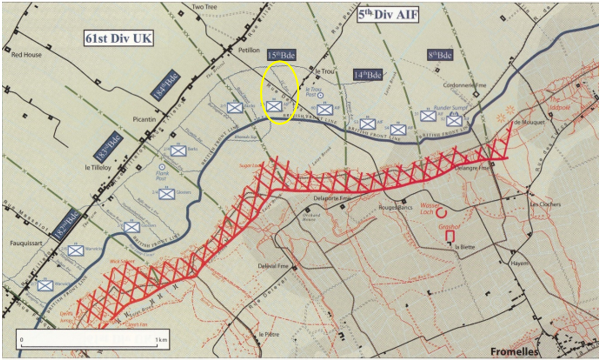
However, if Sarfaty is correct, then Fred was killed in the support trench behind the front line (not shown on above map), before the third wave left hopped-over. Unfortunately, none of the Red Cross interviewees saw Fred’s body being buried. On balance, you would think that a body killed in the support trench area would have been taken away to be buried in the days after the battle rather than be buried next to the trench.
L/Cpl Bywater’s statement recorded earlier notes that “of the small party Sapper Sainty was in, all except one were killed or wounded”. In efforts to identify the party Fred was with when he was killed, the AWM Roll of Honour was examined. It shows that five 14th FCE men were recorded as being killed on 19 or 20 July 1916.
-- Killed 19 July 1916 Sapper 1606 Harry NORTON – no known grave, panel 1 VC Corner
-- Killed 20 July 1916 Sapper 2426 Fred SAINTY – no known grave, panel 1 VC Corner
-- Killed 20 July 1916 Sapper 5363 Cecil P. ASHDOWN – buried Anzac Cemetery, Sailly-sur-la-Lys
-- Killed 20 July 1916 Sapper 5376 Herbert V ETTINGSHAUSEN - no known grave, panel 1 VC Corner
-- Killed 20 July 1916 Sapper 5651 Robert N MURRAY – buried Rue-Petillon Military Cemetery, Fleurbaix
Were these five soldiers in the small party Bywater refers to?
Norton and Ettingshausen have Red Cross files but neither give details of Fred Sainty’s fate. Ettingshausen appears to have been badly wounded but was determined to return to the attack and was never seen again, probably dying in No-man’s land.
It is interesting that Ashdown and Murray’s bodies were taken back to different cemeteries for burial. Perhaps their bodies were found on different parts of the battlefield. This raises the possibility that Fred Sainty could also be in one of these cemeteries, which fits with Sarfaty’s mention of Fred being buried at Fleurbaix or Bac St Maur, and Bywater thinking that Fred was buried at Sailly.
Both the Anzac Cemetery at Sailly-sur-la-Lys and the Rue-Petillon Cemetery at Fleurbaix contain graves of unidentified soldiers so there remains the possibility that Fred Sainty may be buried as an unknown soldier in either of these cemeteries, or even in another nearby.
An alternative theory as to the make-up of the small party referred to by Lance Corporal Bywater is based on evidence given by Driver 5014 Hubert L. PHELPS as part of the Court of Enquiry in September 1917 into the fate of Sapper Norton. Phelps stated that he saw a group of three 14th FCE men “about 70 yards in front of our own line”, namely,
- Sapper 2426 SAINTY who was dead
- Sapper 1606 Harry NORTON, wounded and apparently dying
- L/Corporal 5362 Pearson G. ATKINSON, wounded.
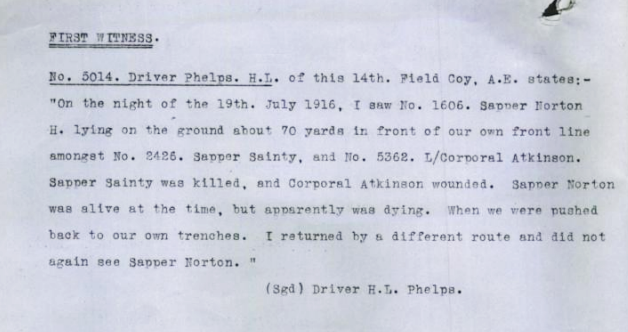
Subsequent records show that both Sainty and Norton were found to have been killed in action on 19/20 July 1916 and, having no known grave, are commemorated on the V.C. Corner Memorial. Records for Atkinson show that he suffered gunshot wounds to neck and shoulder during the Battle of Fromelles and was evacuated to England for treatment; he returned to active service in March 1917 and eventually returned to Australia in 1919.
The description by Driver Phelps aligns fairly well with the description by L/Corporal Bywater and also supports claims that Fred Sainty was killed on 19 July 1916 rather than the official finding of 20 July 1916. Given the passing of time and scarcity of surviving eyewitnesses, it is expected that recollections of dates and times will show considerable variation.
Robert Sweeney appears to have spent some time asking others in the 14th FCE if they knew where Fred was buried. The fact that he ‘drew a blank’ doesn’t necessarily indicate that Fred was left behind and buried post-war. If his body was taken back, but not by members of the 14th FCE, then there is no reason why members of the Company would know what happened to Fred’s body.
While researchers have not been able to establish where Fred Sainty is buried, they have ruled out the possibility that he may have been amongst those 250 men found buried at Pheasant Wood. Fred never made it across No-man’s land. He may be amongst the 410 burials at VC Corner Australian Cemetery and Memorial or buried as an unknown in one of the cemeteries located behind the Australian line.
Dearly loved and remembered
Numerous memorial notices were placed over the years by Fred’s parents, siblings, other family and friends – clearly a dearly loved young man.
Today, Frederick Leslie Sainty is remembered on the following memorials:
- Panel 1, V.C. Corner Australian Cemetery and Memorial, Fromelles, France
- Australian War Memorial Roll of Honour, Canberra, ACT
- Canley Vale Public School First World War Roll of Honour, Canley Vale, NSW
- Substation Staff NSW Government Tramways Honour Roll, Mortuary Station, Chippendale, NSW
- NSW Government Railway and Tramway Honour Board, Central Station, Haymarket, NSW
- Substation Staff of NSW Government Tramways Roll of Honour, (in storage pending relocation) Haymarket, NSW
- Fort Street High School Great War Honour Roll, Petersham, NSW
- Sydney Technical High School WW1 Roll of Honour, Bexley, NSW

Family today continue to honour his memory with many family members contributing to DNA and other research efforts seeking to find Sapper Fred Sainty’s final burial place. Any family who think they may offer further assistance are asked to contact UWCA.
May Private Fred Sainty rest in peace.
Links to Official Records
The Fromelles Association would love to hear from you

Contacts
(Contact: carla@fromelles.info or geoffrey@fromelles.info).
(Contact: army.uwc@defence.gov.au or phone 1800 019 090).
Donations
If you are able, please contribute to the upkeep of this resource.
(Contact: bill@fromelles.info ).
